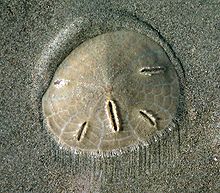Sand Dollar
| Sand dollar Temporal range: 56–0 Ma Late Paleocene to Recent |
|
|---|---|
 |
|
| A live individual of Mellita longifissa | |
| Scientific classification | |
| Kingdom: | Animalia |
| Phylum: | Echinodermata |
| Class: | Echinoidea |
| Subclass: | Euechinoidea |
| Superorder: | Gnathostomata |
| Order: | Clypeasteroida |
| Suborders and families | |
|
See text. |
|
See text.
The term sand dollar (or sea cookie or snapper biscuit in New Zealand, or pansy shell in South Africa) refers to species of extremely flattened, burrowing sea urchins belonging to the order Clypeasteroida. Some species within the order, not quite as flat, are known as sea biscuits. Related animals include other sea urchins, sea cucumbers, and starfish.
Sand dollars, like all members of the order Clypeasteroida, possess a rigid skeleton known as a test. The test consists of calcium carbonate plates arranged in a fivefold radial pattern. In living individuals, the test is covered by a skin of velvet-textured spines which are covered with very small hairs (cilia). Coordinated movements of the spines enable sand dollars to move across the seabed. The velvety spines of live sand dollars appear in a variety of colors—green, blue, violet, or purple—depending on the species. Individuals which are very recently dead or dying (moribund) are sometimes found on beaches with much of the external morphology still intact. Dead individuals are commonly found with their empty test devoid of all surface material and bleached white by sunlight.
The bodies of adult sand dollars, like those of other echinoids, display radial symmetry. The petal-like pattern in sand dollars consists of five paired rows of pores. The pores are perforations in the endoskeleton through which podia for gas exchange project from the body. The mouth of the sand dollar is located on the bottom of its body at the center of the petal-like pattern. Unlike other urchins, the bodies of sand dollars also display secondary front-to-back bilateral symmetry. The anus of sand dollars is located at the back rather than at the top as in most urchins, with many more bilateral features appearing in some species. These result from the adaptation of sand dollars, in the course of their evolution, from creatures that originally lived their lives on top of the seabed (epibenthos) to creatures that burrow beneath it (endobenthos).
...
Wikipedia
